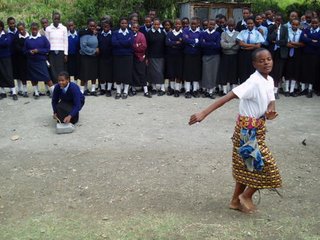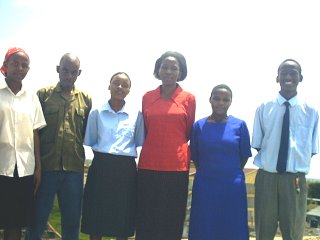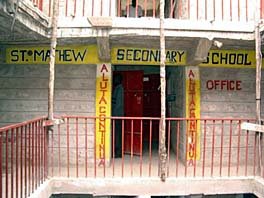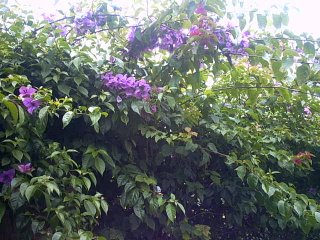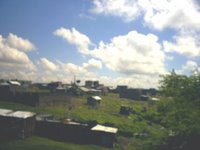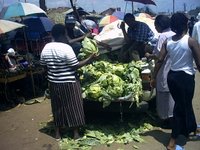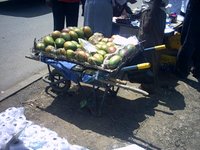:::::::::::::::::::::::::::::::::::::::::::::::::::::::::::::::::::::::::::::::::::::::::::::::::::::
Puddle, puddles
***** Location: Kenya, Guyana
***** Season: Long rains, short rains
............. others see below
***** Category: Earth
*****************************
Explanation
Puddles formation at the roadside is usual in our city during wet seasons.
kenneth daniels (Guyana)
SOUTH AMERICAN SAIJIKI

:::::::::::::::::::::::::::::::::::::::::::::::::::::::::::::::::::::::::::::::::::::::::::::::::::::
quote
A puddle is a small accumulation of liquid, usually water, on a surface. It can form either by pooling in a depression on the surface, or by surface tension upon a flat surface. A puddle is generally considered to be small enough to step over or shallow enough to walk through, and too small to traverse with a boat, raft or submarine.
Puddles commonly form during rainstorms, and can cause problems for transport, especially when combined with cold conditions to form patches of ice, which are highly slippery and difficult to see. Due to the angle of the road, puddles tend to be forced by gravity to gather on the edge of the road. This causes the notorious 'splash' as cars drive quickly through the puddle, which causes water to be sprayed onto pedestrians on the adjacent pavement. A puddle on a road is commonly referred to as a Wooosher. Sometimes, irresponsible drivers will do this deliberately. Such activity is frowned upon, and in some countries can lead to prosecutions for careless driving.
Puddles are often considered a source of recreation by children, who consider jumping in puddles to be an "up-side" to rain.
Biology
Animals often use puddles either as a drinking source, a bath, or, in the case of some smaller animals, an entire habitat. Puddles are also vital for bathing birds.
Puddles which do not evaporate quickly can become standing water, which can become polluted by decaying organisms and are often home to breeding mosquitos, which can act as vectors for diseases such as malaria and of more recent concern in certain areas of the world, West Nile Virus.
Swallows use the damp loam which gathers in puddles as a form of cement to help to build their nests. The reduction in the number of puddles in the countryside due to intensive farming and climate change is partially to blame for a decrease in the swallows' numbers.
© More in the WIKIPEDIA !
*****************************
Worldwide use
Germany and other European regions
Pfütze, Wasserpfütze
topic for haiku
:::::::::::::::::::::::::::::::::::::::::::::::::::::::::::::::::::::::::::::::::::::::::::::::::::::
Japan
mizutamari みずたまり【水溜まり】puddle
topic for haiku
*****************************
Things found on the way
*****************************
HAIKU
wayside puddles
banana skin peelings
on the path
kenneth daniels (GY)
June 2009
:::::::::::::::::::::::::::::::::::::::::::::::::::::::::::::::::::::::::::::::::::::::::::::::::::::
The long rains are subsiding and this is what i saw in the afternoon in the muddy road home as i was coming from school:
desperate tadpole
in the hot scorching sun
dwindling puddle
Harrison Wambua, Nairobi, Kenya
June 2009
:::::::::::::::::::::::::::::::::::::::::::::::::::::::::::::::::::::::::::::::::::::::::::::::::::::
passing rain--
she steps in the puddle to
soften the mud
Caleb David Mutua, Kenya
PUDDLES - More photos by Caleb Mutua
:::::::::::::::::::::::::::::::::::::::::::::::::::::::::::::::::::::::::::::::::::::::::::::::::::::
buy two
get one free--
milk hawker
MORE
Long Rains Haiku
By Patrik Wafula, March 2010
:::::::::::::::::::::::::::::::::::::::::::::::::::::::::::::::::::::::::::::::::::::::::::::::::::::
rain---
a street boy washes his hands
in a puddle
Catherine Njeri
April 2010
:::::::::::::::::::::::::::::::::::::::::::::::::::::::::::::::::::::::::::::::::::::::::::::::::::::
rainy afternoon--
my loose sole sticks
in a muddy puddle
Brian Etole
October 2010
:::::::::::::::::::::::::::::::::::::::::::::::::::::::::::::::::::::::::::::::::::::::::::::::::::::
PUDDLE haiku
Kenya Saijiki Forum
PUDDLES haiku
Kenya Saijiki Forum
:::::::::::::::::::::::::::::::::::::::::::::::::::::::::::::::::::::::::::::::::::::::::::::::::::::
Die dunkle Pfütze -
der Himmel treibt in Blasen
und zerplatzt
Gerd Börner (DE)
source : www.wowwi.orc.ru
:::::::::::::::::::::::::::::::::::::::::::::::::::::::::::::::::::::::::::::::::::::::::::::::::::::
水溜りバシャバシャ歩く童かな
mizudamari baja-baja aruku warabe kana
puddles -
the children walk
with splashing sounds
source : rakuten.co.jp
Tr. Gabi Greve
bajabaja, baja-baja imitates the sound of rubber boots in puddles.
MORE
Japanese haiku with 水たまり
:::::::::::::::::::::::::::::::::::::::::::::::::::::::::::::::::::::::::::::::::::::::::::::::::::::
Puddles and their reflections of the sky are a common theme for haiku ... so nice to observe after a downpoor !
Here are some random samples while googeling
"Who has not read a haiku with the traditional image of a puddle of rain reflecting a leaf, cloud, moon, sky, kite, flower, frog?"
One Haiku, Several Authors
Sky clearing colors of the rainbow from puddle to puddle
After the rain a puddle. Careful. Don't step on the sky
Drops as they splattered. Into the puddle
One shoe slaps puddle. Cold water flies everywhere. Other foot gets wet.
The moon is reflected even in a puddle an inch wide
Muddy dirt puddle, Meaning nothing to people, Reflects the bright moon
puddle after puddle— the bright color of her long raincoat.
Trailer park girl rolls in puddle. Left by afternoon rain
frozen puddles– the crack of axes from four directions
MORE
Haiku with a puddle
googeling "in each puddle"
after summer storm a moon in each puddle
up in each puddle this stone left by a lizard still warm
...... while stepping on the moon in each puddle
MORE googeling :
Haiku with "in each puddle"
.................................................................................
after the storm -
paulownia blossoms
in each puddle
Gabi Greve, May 2007
*****************************
Related words
***** SOUTH AMERICAN SAIJIKI
:::::::::::::::::::::::::::::::::::::::::::::::::::::::::::::::::::::::::::::::::::::::::::::::::::::
Back to the Worldkigo Index
:::::::::::::::::::::::::::::::::::::::::::::::::::::::::::::::::::::::::::::::::::::::::::::::::::::










